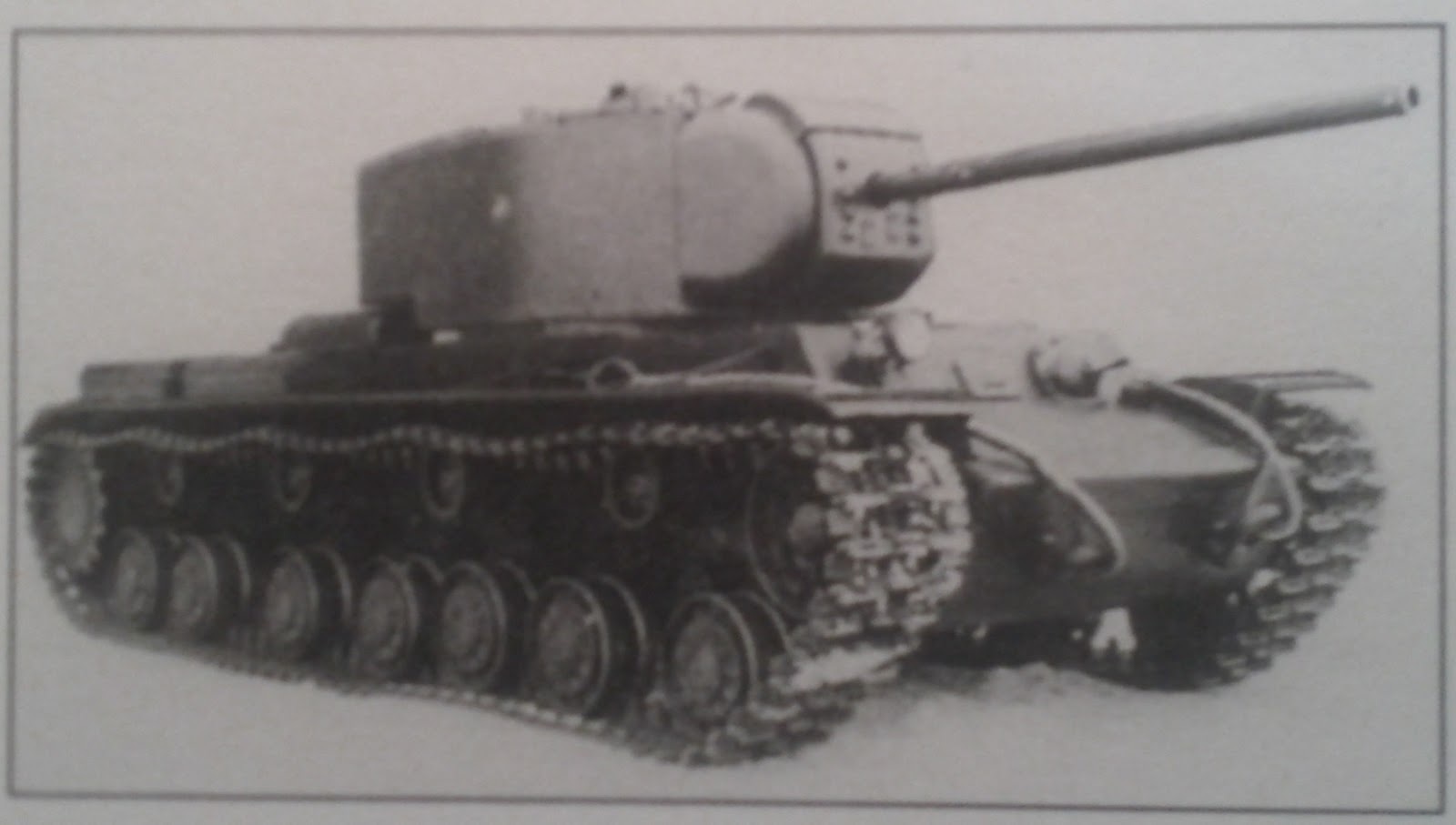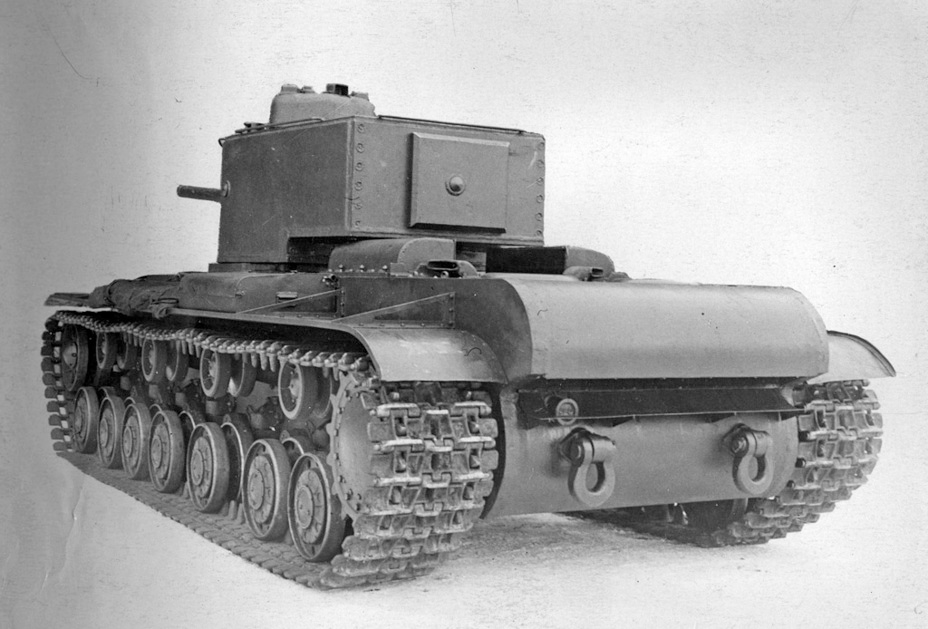| Golden Journal No. 54
Stalin’s Tanks
The KV220 Disaster
by Mike Bennighof, Ph.D.
October 2024
 Even as the KV-series of heavy tanks began production in March 1940, the Red Army’s Armored Forces Directorate remained unsatisfied. The KV-1 boasted thick armor, but only the same 76.2mm main gun as the T-34 medium tank. Improvements continued while tanks came off the assembly line at Leningrad’s Kirov Plant, and each tank differed slightly from its predecessors. Rumors of much heavier German tanks in development indicated that the KV needed a heavier gun to deal with them, and in May 1940 the Armored Forces Directorate ordered the Kirov Plant’s design bureau to make yet another improvement: a KV variant carrying a high-velocity 85mm gun. The Communist Party’s Central Committee confirmed the directive on 17 June. Even as the KV-series of heavy tanks began production in March 1940, the Red Army’s Armored Forces Directorate remained unsatisfied. The KV-1 boasted thick armor, but only the same 76.2mm main gun as the T-34 medium tank. Improvements continued while tanks came off the assembly line at Leningrad’s Kirov Plant, and each tank differed slightly from its predecessors. Rumors of much heavier German tanks in development indicated that the KV needed a heavier gun to deal with them, and in May 1940 the Armored Forces Directorate ordered the Kirov Plant’s design bureau to make yet another improvement: a KV variant carrying a high-velocity 85mm gun. The Communist Party’s Central Committee confirmed the directive on 17 June.
Artillery savant V.S. Grabin and his team at Gorki’s Plant No. 92 immediately got to work on a suitable 85mm gun. The 76.2mm F34, a greatly improved weapon that would arm the Model 1941 T34, became the basis for the new 85mm F30 design. Grabin gave the new cannon the same ballistic profile as the Model 1939 85mm anti-aircraft gun (a weapon not designed by Grabin and his bureau). The Model 1939 had been issued not only for anti-aircraft defense but to the newly-forming separate anti-tank brigades for ground use, and Soviet planners considered it a very potent counter to even the heaviest enemy tanks.

The KV220 prototype.
Grabin’s new tank cannon would not fit in the standard KV1 turret, requiring design of a new machine to accommodate it. Along with the new gun came a new requirement, that the tank be capable of withstanding the fire of its own weapon, meaning that armor would have to be thickened from 75mm to 100mm.
The project went to J.Y. Kotin’s SKB-2 design bureau, and Kotin gave it to his most experienced engineers. The problem would be profound: the KV1 already waddled along slowly under its weight, and now the Armored Forces Directorate demanded – in the name of J.V. Stalin – a tank with a much heavier gun, a bigger turret to house it, and more armor.
The assignment also included a variant carrying the 76.2mm F34, but that weapon could be fitted to the T34 without major modifications and did not require a new KV turret. At some point Kotin’s team dropped that project to concentrate on the version armed with the 85mm gun. The Directorate gave deadlines of September 1940 for a working prototype of the cannon and December for one of the new-model KV. Meanwhile, with the tank still a series of sketches at SKB-2, production targets for 1941 called for half of all KV production to be of the new tank, designated the KV220.
The cannon met its deadline, just barely, and then failed its initial tests with poor performance and a split in its breach. Not until late October did the 85mm F30 – mounted in Plant No. 92’s trusty T28 testbed – complete a successful round of test firing. The team dismounted it and shipped the gun to the Kirov Works, with a second cannon following a few days later.

Rear view of the KV220 and its turret.
The tank designers had plenty of problems of their own. The standard KV could not possibly meet the design specifications, and so they had to lengthen it to accommodate a larger turret. The heavier armor required a bigger engine, going from 600 to 850 horsepower with the addition of a supercharger to the already-unreliable engine that powered the KV1. They did take the opportunity to replace the problematic transmission of the KV1 with a completely new design.
To house the big F30 cannon, they designed a modified version of the towering turret of the KV2 artillery tank, with the same footprint but not nearly so tall. Like the KV2 turret, it had a large hatch on the rear to allow the main gun to be removed. Unlike the KV2 turret, it had an innovative machine-gun turret atop its roof that also served as the commander’s cupola. But while it met Great Stalin’s demand for extra-heavy armor, this was a slab-sided affair without the slope of the T34 or even KV1 turrets, somewhat lessening the added protection offered. But the huge turret at least gave the crew room to operate the huge gun. The turret was welded, with reinforcing rods inside; its bustle carried 15 rounds for the 85mm gun, with 76 more stored within the hull. A machine gun mounted alongside the cannon, and another in a ball mount in the front of the hull, completed the armament. A crew of six operated the 63-ton monster.
The hull, built at the Izhora Works, arrived at the Kirov Plant on 7 December 1940, after the deadline for the completed prototype. Kotin’s crew rushed to assemble their tank, and finally had to ready on 14 January 1941, but they cut a significant corner by skipping factory trials. The tank would attempt to move under its own power for the first time, but one of the engineers decided that it should at least be fired up once before shipping; main bearing melted before it could get across the factory floor. The team installed a new engine, and packed it off to the Kubinka Proving Grounds.

The KV220 prototype and its protective canvas, at Kubinka.
These initial trials would only test the tank’s mechanical qualities; the F30 cannon had been found to be unbalanced when installed and it could not yet be fired from the K220. The team tasked with assembling the prototype also reported their belief that the cannon’s foot trigger would not work. And so the trials would take place with a heavy canvas hood over the gun and turret, to assure that no further damage came from the weather and flying mud.
They need not have worried; the engine promptly melted down again on the first day of mobility trials, 25 January. Examination found that it spat oil all over its housing and out of its cooling vents, and the heat also melted its piston rings. During its brief 108-kilometer jaunt through the mud of Kubinka. It was also shown to be enormously slow, clocking a maximum speed of 21.2 kilometers per hour. No spare engine had been sent with the prototype, and when a new one arrived a few days later, it also melted down on 3 February. The third engine arrived on the 15th, and it turned out to be a 700-horsepower model.
By that point, the Artillery Director, Marshal Grigory Kulik, had seen enough. In a fit of rage, he ordered the turret removed from the KV220 and shipped to Grabin in Gorkiy for the cannon to be properly balanced and mounted. The hull went back to Leningrad, and Kulik ordered a commission formed to investigate the incompetence and possible sabotage behind the repeated engine failures.
Knowing Kulik to be obsessed with the thought of a super-powered 107mm tank gun, Grabin diverted the rather dull-witted marshal by dangling the thought of mounting it in the KV220. The KV220 could not accommodate the bigger gun, and so a new design would be needed, a development that eventually led to the KV5 heavy tank. Kulik appears to have forgotten his rage in his obsession for a super-powered heavy tank, as no one was apparently imprisoned or shot for the repeated failures of the KV220 project.

Pulling the KV220’s engine after one of its serial failures.
A second prototype had been under construction, but work now stopped. In October 1941 an order came to prepare all experimental tanks for front-line service, and a standard KV1 turret was mounted on one of the two prototypes (it’s unclear which) and the tank was shipped to the 124th Tank Brigade fighting along the Tosna River near Mga, just east of Leningrad. Designated “For the Motherland,” the tank saw brief action in December 1941 before taking a direct hit from a German 150mm howitzer that penetrated the turret and exploded the ready ammunition stores, killing the crew instantly and blowing the vehicle apart. Some Soviet sources claim it was retrieved and repaired, and then assigned to the 12th Independent Tank Training Regiment, but this was probably the incomplete second prototype, which never went to the front (though this tank was also officially designated “For the Motherland” without a number).
The KV220’s utter failure was Red Army’s the most expensive tank project to date, costing over four million rubles (the previous holder of that title, the T35 “land battleship,” had cost 1.5 million rubles). A much more suitable 85mm gun, Fyodor Petrov’s D5-T, would win a design competition over Grabin’s entry in 1943 and equip a whole series of tanks. But that’s another story.
 Golden Journal No. 54: Stalin’s Tanks includes the KV220, so you can slay Tigers and Panthers on the battlefields of Kursk. Golden Journal No. 54: Stalin’s Tanks includes the KV220, so you can slay Tigers and Panthers on the battlefields of Kursk.
The Golden Journal is only available to the Gold Club (that’s why we call it the Golden Journal).
Click here to join the Gold Club.
See your Gold Club Insider newsletter for ordering information.
Sign up for our newsletter right here. Your info will never be sold or transferred; we'll just use it to update you on new games and new offers.
Mike Bennighof is president of Avalanche Press and holds a doctorate in history from Emory University. A Fulbright Scholar and NASA Journalist in Space finalist, he has published a great many books, games and articles on historical subjects; people are saying that some of them are actually good.
He lives in Birmingham, Alabama with his wife, three children, and new puppy. He misses his lizard-hunting Iron Dog, Leopold.
Daily Content includes no AI-generated content or third-party ads. We work hard to keep it that way, and that’s a lot of work. You can help us keep things that way with your gift through this link right here.
|
